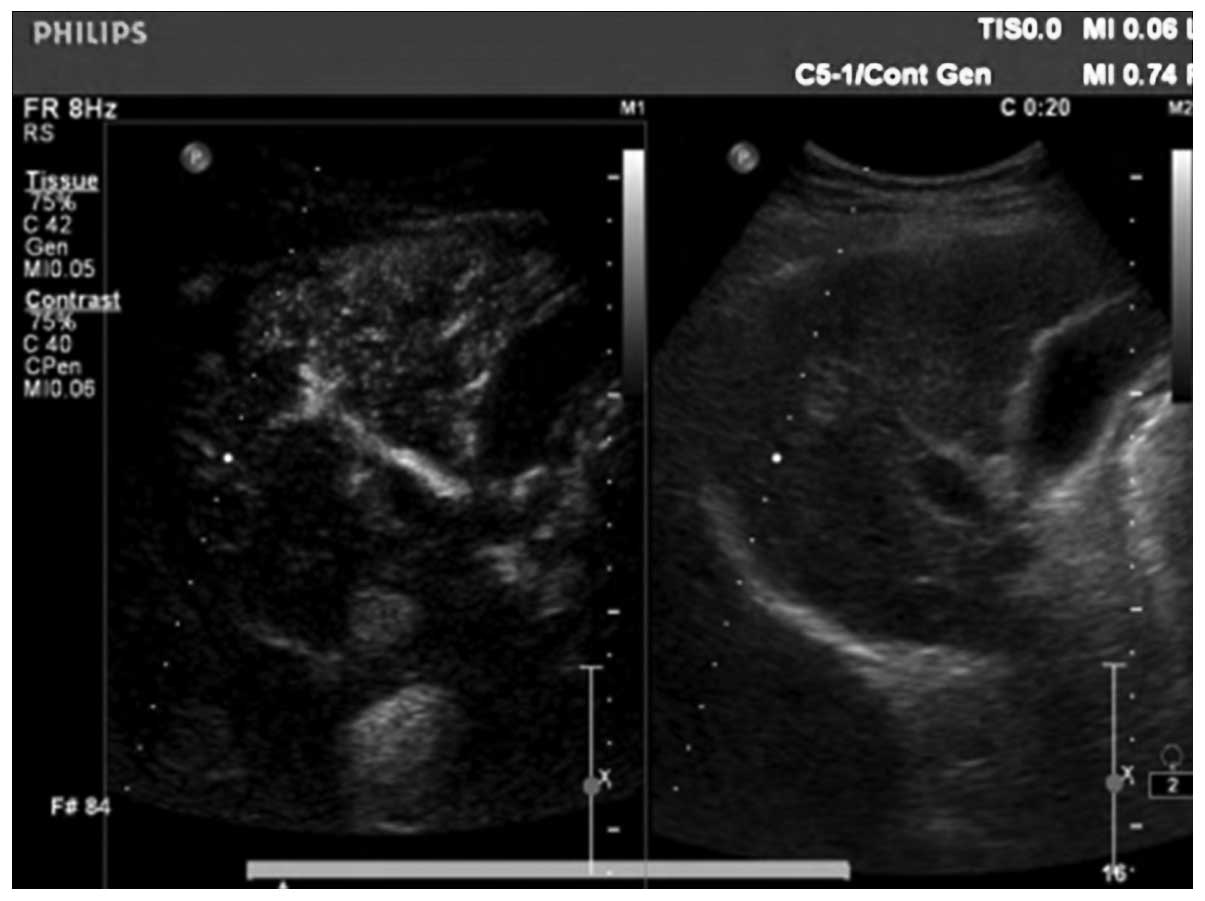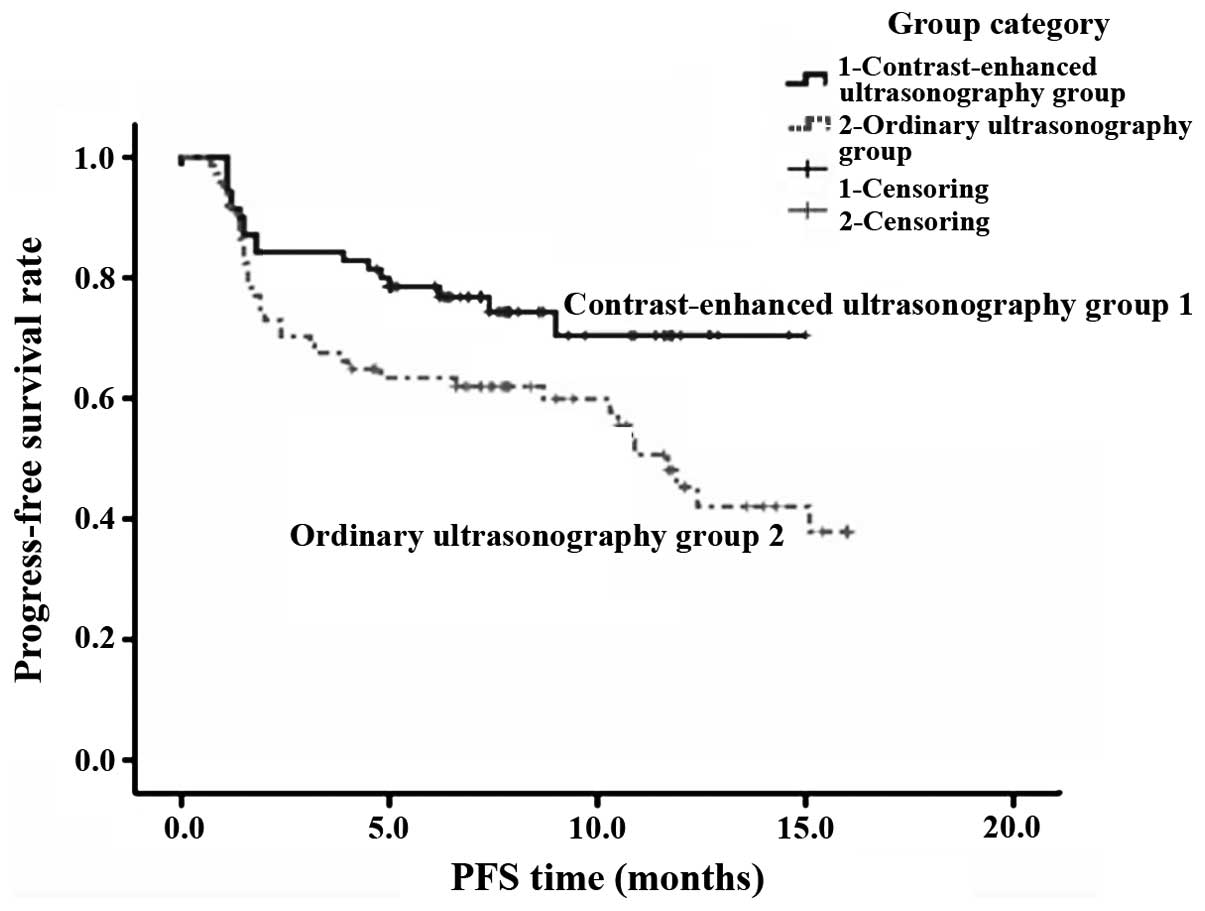|
1
|
Kim AY, Lee MW, Rhim H, Cha DI, Choi D,
Kim YS, Lim HK and Cho SW: Pretreatment evaluation with
contrast-enhanced ultrasonography for percutaneous radiofrequency
ablation of hepatocellular carcinomas with poor conspicuity on
conventional ultrasonography. Korean J Radiol. 14:754–763. 2013.
View Article : Google Scholar : PubMed/NCBI
|
|
2
|
Shah DR, Green S, Elliot A, McGahan JP and
Khatri VP: Current oncologic applications of radiofrequency
ablation therapies. World J Gastrointest Oncol. 5:71–80. 2013.
View Article : Google Scholar : PubMed/NCBI
|
|
3
|
Mauri G, Cova L, De Beni S, Ierace T,
Tondolo T, Cerri A, Goldberg SN and Solbiati L: Real-time US-CT/MRI
image fusion for guidance of thermal ablation of liver tumors
undetectable with US: results in 295 cases. Cardiovasc Intervent
Radiol. 38:143–151. 2015. View Article : Google Scholar : PubMed/NCBI
|
|
4
|
Wolf FJ, Aswad B, Ng T and Dupuy DE:
Intraoperative microwave ablation of pulmonary malignancies with
tumor permittivity feedback control: ablation and resection study
in 10 consecutive patients. Radiology. 262:353–360. 2012.
View Article : Google Scholar : PubMed/NCBI
|
|
5
|
Nazem F, Ahmadian A, Seraj ND and Giti M:
Two-stage point-based registration method between ultrasound and CT
imaging of the liver based on ICP and unscented Kalman filter: a
phantom study. Int J CARS. 9:39–48. 2014. View Article : Google Scholar
|
|
6
|
Bruix J and Sherman M: American
Association for the Study of Liver Diseases: Management of
hepatocellular carcinoma: an update. Hepatology. 53:1020–1022.
2011. View Article : Google Scholar : PubMed/NCBI
|
|
7
|
Sporea I, Badea R, Martie A, Dumitru E,
Ioaniţescu S, Şirli R, Socaciu M, Popescu A, Dănilă M and
Voiculescu M: Contrast Enhanced Ultrasound for the evaluation of
focal liver lesions in daily practice. A multicentre study. Med
Ultrason. 14:95–100. 2012.PubMed/NCBI
|
|
8
|
Takahashi M, Maruyama H, Shimada T,
Kamezaki H, Sekimoto T, Kanai F and Yokosuka O: Characterization of
hepatic lesions (≤30 mm) with liver-specific contrast agents: a
comparison between ultrasound and magnetic resonance imaging. Eur J
Radiol. 82:75–84. 2013. View Article : Google Scholar : PubMed/NCBI
|
|
9
|
Sparchez Z, Radu P, Zaharia T, Kacso G,
Grigorescu I, Botis G and Badea R: Usefulness of contrast enhanced
ultrasound guidance in percutaneous biopsies of liver tumors. J
Gastrointestin Liver Dis. 20:191–196. 2011.PubMed/NCBI
|
|
10
|
Zhang D, Liang P, Yu X, Cheng Z, Han Z, Yu
J and Liu F: The value of artificial pleural effusion for
percutaneous microwave ablation of liver tumour in the hepatic
dome: a retrospective case-control study. Int J Hyperther.
29:663–670. 2013. View Article : Google Scholar
|
|
11
|
Widmann G, Schullian P, Haidu M and Bale
R: Stereotactic radiofrequency ablation (SRFA) of liver lesions:
technique effectiveness, safety, and interoperator performance.
Cardiovasc Intervent Radiol. 35:570–580. 2012. View Article : Google Scholar : PubMed/NCBI
|
|
12
|
Mariani A, Kwiecinski W, Pernot M, Balvay
D, Tanter M, Clement O, Cuenod CA and Zinzindohoue F: Real time
shear waves elastography monitoring of thermal ablation: in vivo
evaluation in pig livers. J Surg Res. 188:37–43. 2014. View Article : Google Scholar : PubMed/NCBI
|
|
13
|
Liu F, Liang P, Yu X, Lu T, Cheng Z, Lei C
and Han Z: A three-dimensional visualisation preoperative treatment
planning system in microwave ablation for liver cancer: a
preliminary clinical application. Int J Hyperther. 29:671–677.
2013. View Article : Google Scholar
|
|
14
|
Wang XL, Li K, Su ZZ, Huang ZP, Wang P and
Zheng RQ: Assessment of radiofrequency ablation margin by MRI-MRI
image fusion in hepatocellular carcinoma. World J Gastroenterol.
21:5345–5351. 2015. View Article : Google Scholar : PubMed/NCBI
|
|
15
|
Correa-Gallego C, Karkar AM, Monette S,
Ezell PC, Jarnagin WR and Kingham TP: Intraoperative ultrasound and
tissue elastography measurements do not predict the size of hepatic
microwave ablations. Acad Radiol. 21:72–78. 2014. View Article : Google Scholar : PubMed/NCBI
|
|
16
|
Mauri G, Porazzi E, Cova L, Restelli U,
Tondolo T, Bonfanti M, Cerri A, Ierace T, Croce D and Solbiati L:
Intraprocedural contrast-enhanced ultrasound (CEUS) in liver
percutaneous radiofrequency ablation: clinical impact and health
technology assessment. Insights Imaging. 5:209–216. 2014.
View Article : Google Scholar : PubMed/NCBI
|
|
17
|
Asvadi NH, Anvari A, Uppot RN, Thabet A,
Zhu AX and Arellano RS: CT-guided percutaneous microwave ablation
of tumors in the hepatic dome: assessment of efficacy and safety. J
Vasc Interv Radiol. 27:496–502. 2016. View Article : Google Scholar : PubMed/NCBI
|
|
18
|
Zhang M, Liang P, Cheng ZG, Yu XL, Han ZY
and Yu J: Efficacy and safety of artificial ascites in assisting
percutaneous microwave ablation of hepatic tumours adjacent to the
gastrointestinal tract. Int J Hyperther. 30:134–141. 2014.
View Article : Google Scholar
|
|
19
|
Li M, Yu XL, Liang P, Liu F, Dong B and
Zhou P: Percutaneous microwave ablation for liver cancer adjacent
to the diaphragm. Int J Hyperther. 28:218–226. 2012. View Article : Google Scholar
|
|
20
|
Wu J, Yang W, Yin S, Wu J, Wu W, Yan K and
Chen M: Role of contrast-enhanced ultrasonography in percutaneous
radiofrequency ablation of liver metastases and efficacy
evaluation. Chin J Cancer Res. 25:143–154. 2013.PubMed/NCBI
|











